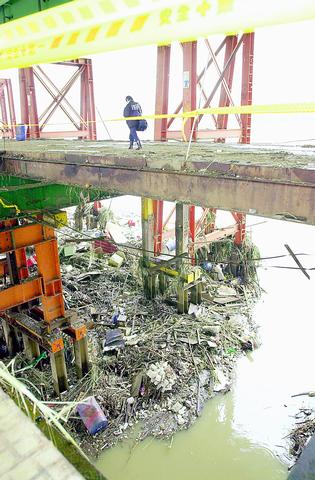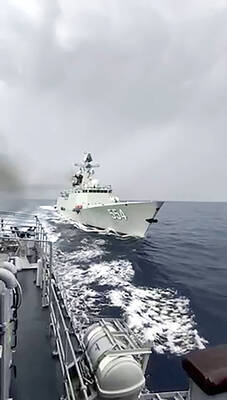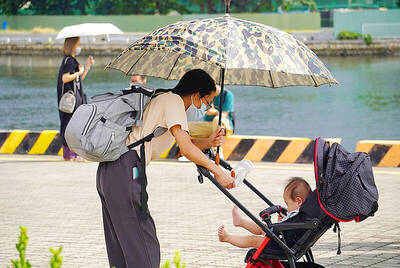As many residents of Taipei are still putting their lives back together after the worst flooding the city has seen in many years, officials are already trying to pass the buck on to who, if anyone, should be responsible.
Last Tuesday and Wednesday, Typhoon Xangsane (
Facing public complaints and severe criticism from city councilors, the Taipei City Government has said that the flooding was solely caused by the torrential rains. Academics and city councilors, however, pointed fingers at the city government for having failed to draw up a comprehensive river dredging program. They also say that urban sprawl on hillsides and in low-lying areas has been allowed to grow out of control.

PHOTO: CHANG CHIA-MING, TAIPEI TIMES
It's the rain
On Nov. 1, Taipei Deputy Mayor Ou Chin-der (
The last time Taipei City had similar amounts of rainfall was in October 1977.
Director of the city's Bureau of Public Works (
"The rainfall was not only heavy but also highly concentrated in certain areas," he said. "Take the Nankang district, for example. The accumulated rainfall amounted to 473.5mm in the Chiuchuang area (舊庄). In the Wenshan district, 523mm of rain fell in Pochia borough (博嘉里)."
According to figures on the Web site of the Central Weather Bureau, the monthly mean precipitation for Taipei in November is 79.8mm.
A contributing factor of the flooding, according to Lee, is the over-development of upstream areas.
"The ability of the soil to retain water has been so weakened that when heavy rain falls, the soil which is already saturated with water cannot handle any more. The result is that the water remains on the surface and contributes to serious flooding."
In addition to ground saturation is the fact that a project to contain floodwaters along the rivers remains incomplete, increasing the risk of flooding, Lee said.
"Since the embankments constructed along the Keelung River and Chingmei Creek are not yet fully complete, the districts of Neihu, Nankang, and Wenshan are at risk," he said.
According to Lee, the levee built along the right side of the Keelung River off Nanhu Bridge (
Although the city plans to build a levee along Chingmei Creek off Wanshou Bridge (
Despite the claim made by the city government, city councilors expressed different views regarding the cause of the flooding.
Voices from the city council
Leading a group of reporters on an inspection tour of the MacArthur First Bridge (
The MacArthur First Bridge, which connects Neihu and Sungshan districts over the Keeling River and separates Neihu in the north and Nankang in the south, became operational recently.
"At the height of the typhoon, the water level upstream was 1m higher than downstream. If the water flow wasn't blocked by the bridge and ultimately caused the flooding, I don't know what else it was," he said.
Looking down from the temporary work station beneath the bridge, Chen pointed to the garbage scattered around the construction site and along the riverbank. Among the entangled branches and styrofoam products lay a 22.5-tonne oil tank and a barge.
"The city keeps saying that the flooding was caused by the heavy rainfall. If what it says is true, how come Shetzu Islet (
Shetzu Islet, a 300-hectare sandbar located at the junction of the Tamshui River and its tributary, the Keelung River, is normally flooded every year when typhoons strike.
Another city councilor of the same districts, Lee Yen-hsiu (
"First of all, the timing of the water released from the Feitsui Dam (
Different municipal agencies are also trying to shirk responsibility for dredging the rivers, she said.
Take Takeng Creek (大坑溪) in the Nankang district for example, she said. While the upstream area belongs to the city's Department of Public Housing (國宅處), the midstream section is under the jurisdiction of the Office of Market Supervision (市管處) under the city's Bureau of Reconstruction (建設局), while the downstream area is supervised by yet another department.
"Believe me, it's not easy to have them dredge the creek," she said.
New Party City Councilor Lee Ching-yuan (李慶元) of the Wenshan and Ta-an districts agreed.
"The city needs to review the overall anti-flooding program and to come up with a comprehensive and long-term plan instead of trivial short-term programs," he said.
Looking at Chingmei Creek -- which runs through the Wenshan district from east to west -- it's easy to see that some areas either don't have any levees or have levees that are poorly designed or constructed, and some areas either have no pumping stations or ones that are insufficient, he said.
Looking for a method
It is conceivable that the city's dredging program needs further review and improvement, but is building more levees the best and only way for flood prevention, or are there alternatives?
"It's not a good idea to keep raising the height of levees," said Hsia Chu-joe (
It's a better idea to strictly control urban development, especially along the river basin and low-lying areas, he said.
"Some low-lying areas are simply not habitable, but what can you do if the government keeps issuing construction licenses, allowing more houses to be built and more people to take land away from the river?" he said.
"It may not be too late for the government to review what direction the city should take in future urban development," he said.
Hsia added that he disapproved of a recent dredging proposal made by the central government.
On Friday, Premier Chang Chun-hsiung (
The project would build a floodway starting in Juifang (
"Many scientific assessments -- such as soil analysis and environmental impact studies -- need to be made before the project begins," Hsia said. "If the assessment results show that the project is feasible, it doesn't necessarily mean, however, that it's all right to keep abusing hillsides and low-lying areas."
National Taiwan University civil engineering professor Kuo Jan-tai (
"I think it's a great idea," he said. "It's cheaper than the traditional methods of dredging."
According to Kuo, it may cost roughly NT$30 billion to build the floodway and the embankment and pumping stations, while it may cost over NT$100 billion to raise the height of existing levees, build more pumping stations, and relocate residents living in low-lying areas.
"To solve the flooding problem in Taipei once and for all, the `structural' and `non-structural' methods should be applied simultaneously," he said.
The so-called "structural" method refers to the construction of embankments, reservoirs and pumping stations. The "non-structural" method refers to urban planning and development in conjunction with an alarm system to alert residents of imminent flooding.

DEFENDING DEMOCRACY: Taiwan shares the same values as those that fought in WWII, and nations must unite to halt the expansion of a new authoritarian bloc, Lai said The government yesterday held a commemoration ceremony for Victory in Europe (V-E) Day, joining the rest of the world for the first time to mark the anniversary of the end of World War II in Europe. Taiwan honoring V-E Day signifies “our growing connections with the international community,” President William Lai (賴清德) said at a reception in Taipei on the 80th anniversary of V-E Day. One of the major lessons of World War II is that “authoritarianism and aggression lead only to slaughter, tragedy and greater inequality,” Lai said. Even more importantly, the war also taught people that “those who cherish peace cannot

Taiwanese Olympic badminton men’s doubles gold medalist Wang Chi-lin (王齊麟) and his new partner, Chiu Hsiang-chieh (邱相榤), clinched the men’s doubles title at the Yonex Taipei Open yesterday, becoming the second Taiwanese team to win a title in the tournament. Ranked 19th in the world, the Taiwanese duo defeated Kang Min-hyuk and Ki Dong-ju of South Korea 21-18, 21-15 in a pulsating 43-minute final to clinch their first doubles title after teaming up last year. Wang, the men’s doubles gold medalist at the 2020 and 2024 Olympics, partnered with Chiu in August last year after the retirement of his teammate Lee Yang

The Philippines yesterday criticized a “high-risk” maneuver by a Chinese vessel near the disputed Scarborough Shoal (Huangyan Island, 黃岩島) in a rare incident involving warships from the two navies. The Scarborough Shoal — a triangular chain of reefs and rocks in the contested South China Sea — has been a flash point between the countries since China seized it from the Philippines in 2012. Taiwan also claims the shoal. Monday’s encounter took place approximately 11.8 nautical miles (22km) southeast” of the Scarborough Shoal, the Philippine military said, during ongoing US-Philippine military exercises that Beijing has criticized as destabilizing. “The Chinese frigate BN 554 was

The number of births in Taiwan fell to an all-time monthly low last month, while the population declined for the 16th consecutive month, Ministry of the Interior data released on Friday showed. The number of newborns totaled 8,684, which is 704 births fewer than in March and the lowest monthly figure on record, the ministry said. That is equivalent to roughly one baby born every five minutes and an annual crude birthrate of 4.52 per 1,000 people, the ministry added. Meanwhile, 17,205 deaths were recorded, resulting in a natural population decrease of 8,521, the data showed. More people are also leaving Taiwan, with net